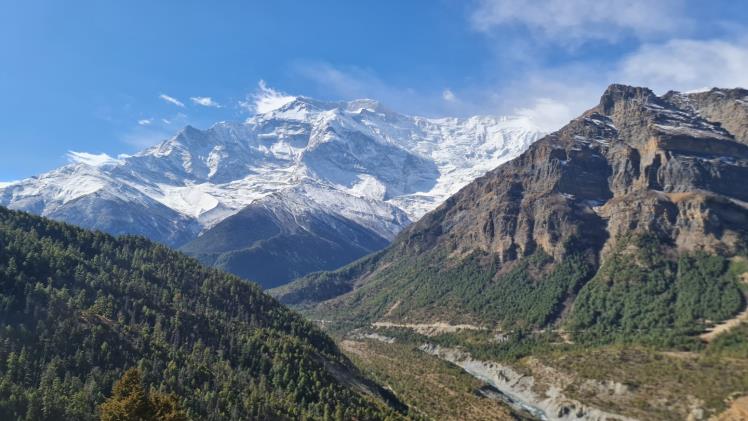Annapurna Circuit vs Everest Base Camp: Which is the Right Trek?

Among the many trekking routes, two stand out as iconic: the Annapurna Circuit and the Everest Base Camp (EBC) trek. Both offer world-class experiences, but they are very different in terms of terrain, culture, challenges, and rewards. Deciding which trek is right for you depends on what kind of adventure you are seeking.
In this guide, we will compare the Annapurna Circuit and Everest Base Camp treks across different aspects such as duration, landscapes, cultural encounters, mountain views, difficulty, altitude, and overall trekking experience. By the end, you will have a clear idea of which trek suits your preferences.
Duration and Itinerary
The Annapurna Circuit Trek traditionally takes between 14 to 20 days, depending on the route chosen and whether side trips are included. The trek usually begins from Dharapani or Bhulbhule and follows a circuit around the Annapurna Massif, eventually crossing the famous Thorong La Pass at 5,416 meters before descending to the Mustang and Kali Gandaki Valley. With road construction shortening certain sections, trekkers often customize the trek by skipping some road-linked areas and focusing on the high mountain trails.
In contrast, the Everest Base Camp Trek is more straightforward and typically takes 12 to 15 days. The journey begins with a thrilling flight to Lukla and follows a single trail through Namche Bazaar, Tengboche, Dingboche, and Lobuche, finally reaching the iconic Everest Base Camp at 5,364 meters. Many trekkers also climb Kala Patthar (5,545 meters) for sweeping sunrise views over Mount Everest. While shorter than the Annapurna Circuit, the EBC trek is packed with cultural and scenic highlights in a linear journey.
Trek Highlights
The Annapurna Circuit’s highlights lie in its diversity. Trekkers walk through subtropical forests, rice terraces, pine-clad valleys, alpine meadows, and high-altitude deserts within a single journey. The climax is crossing Thorong La Pass, one of the highest trekking passes in the world. Other highlights include the sacred site of Muktinath, the apple orchards of Marpha, and the deepest gorge in the world at Kali Gandaki.
The Everest Base Camp trek is focused on one central goal: standing at the foot of the world’s tallest mountain. Along the way, trekkers pass through bustling Sherpa villages like Namche Bazaar, visit the spiritual Tengboche Monastery, and enjoy jaw-dropping views of Everest, Lhotse, Ama Dablam, and Nuptse. The sense of achievement of reaching Everest Base Camp itself is a highlight unlike any other.
Mountain Views
Both treks are known for their stunning Himalayan views, but the panoramas differ in character.
The Annapurna Circuit offers a sweeping variety of peaks, including Annapurna I (8,091m), Dhaulagiri (8,167m), Machhapuchhre (Fishtail), Manaslu, Tilicho Peak, and Gangapurna. Trekkers get to see these giants from multiple angles as the route circles around the massif. The changing perspectives and the sheer number of peaks visible make it one of the most scenic treks in the world.
The Everest Base Camp trek focuses more on Everest and its neighboring giants. Views of Everest itself are often partially hidden from the trail, but Kala Patthar provides an unparalleled vantage point. Along the way, Ama Dablam steals the show with its elegance, while the Khumbu Icefall and towering Lhotse-Nuptse wall provide dramatic scenery. For those who dream of seeing Mount Everest up close, this trek is unbeatable.
Cultural Encounters
The Annapurna Circuit is culturally diverse, offering exposure to both Hindu and Buddhist traditions. In the lower regions, trekkers pass through Gurung and Brahmin villages, while higher up, Tibetan-influenced communities dominate. The ancient monasteries of Braga and the sacred pilgrimage site of Muktinath showcase the region’s spiritual depth. The cultural variety mirrors the geographical diversity of the trek.
The Everest Base Camp trek, on the other hand, immerses trekkers in Sherpa culture. Known for their mountaineering prowess, the Sherpa people also have a deeply rooted Buddhist tradition. Colorful prayer flags, chortens, and monasteries line the trail. Visiting Tengboche Monastery and interacting with Sherpa communities in Namche and Khumjung offer a unique cultural experience centered on Himalayan Buddhism.
Difficulty and Acclimatization
Both treks are challenging, but the nature of the difficulty differs.
The Annapurna Circuit Trek involves long days of walking and the daunting challenge of crossing Thorong La Pass. The altitude gain is more gradual, allowing for natural acclimatization, though trekkers must still be cautious at higher points. The trails can be rugged and long, demanding good physical fitness.
The Everest Base Camp Trek is less about steep passes and more about continuous exposure to altitude. Starting from Lukla at 2,860 meters, trekkers ascend steadily into the high-altitude Khumbu Valley, spending multiple nights above 4,000 meters. Altitude sickness is a serious concern, and acclimatization days in Namche and Dingboche are essential. While the trek does not involve a pass as high as Thorong La, the prolonged stay at high elevation makes it physically and mentally demanding.
Best Time to Trek
Both treks share the same best seasons: spring (March to May) and autumn (September to November).
In spring, rhododendrons bloom along the Annapurna trails, adding vibrant colors to the landscape. The Everest region also enjoys clearer skies and milder temperatures. Autumn brings crisp air, stable weather, and outstanding visibility, making it the most popular season for both treks.
Winter trekking is possible but challenging, especially over Thorong La on the Annapurna Circuit, which can be blocked by snow. In Everest, winter means colder nights but fewer crowds. Monsoon season (June to August) brings heavy rain to the Annapurna region and cloudy conditions in Everest, making it less ideal.
Accessibility and Logistics
Accessibility is another area where the two treks differ.
The Annapurna Circuit begins with a long drive from Kathmandu to Besisahar or Dharapani, often taking 7–10 hours. Roads have been extended into parts of the trail, which can shorten or disrupt the trekking experience depending on your preferences. However, the circuit is well-supported with teahouses, lodges, and services throughout.
The Everest Base Camp trek requires a flight to Lukla, which is both exciting and unpredictable. Weather delays are common, and trekkers should be prepared for changes in schedule. Once in Lukla, the trail is straightforward, with plenty of teahouses and facilities catering to trekkers. The region is more commercialized than Annapurna, but this also means better infrastructure for those heading to EBC.
Uniqueness of Experience
The Annapurna Circuit stands out for its diversity. Few treks in the world offer such a range of landscapes, from lush valleys to high passes and arid deserts, all within a single route. The mix of cultures, scenery, and the sense of completing a full circuit around one of the world’s great mountain ranges make it a unique adventure.
The Everest Base Camp trek is iconic for its singular goal: reaching the base of the world’s highest peak. The sense of walking in the footsteps of legendary climbers like Hillary and Tenzing adds historical weight to the journey. While it may not have the same variety as Annapurna, the emotional and symbolic significance of Everest makes it one of the most inspiring treks globally.
Cost Considerations
In terms of cost, both treks can vary depending on whether you choose guided packages, independent trekking, or luxury options.
The Annapurna Circuit is generally more affordable. Transportation to the trailhead is by road, permits are cheaper, and the cost of food and lodging in the Annapurna region is slightly lower than in the Everest region.
The Everest Base Camp trek tends to be more expensive, mainly due to the flight to Lukla, higher food costs, and the popularity of the route. However, the additional cost is often justified for trekkers who want to achieve the dream of standing at the foot of Mount Everest.
Which One is Right for You?
Choosing between the Annapurna Circuit and the Everest Base Camp trek depends on your personal goals.
If you want a trek that offers diversity in landscapes, culture, and experiences, the Annapurna Circuit may be the better option. It provides a sense of exploration, varied scenery, and a complete circuit experience that few other treks can match.
If your dream is to see Mount Everest up close, immerse yourself in Sherpa culture, and walk a historic trail that has inspired mountaineers for decades, then Everest Base Camp is the right choice. It is more direct, emotionally powerful, and offers a once-in-a-lifetime achievement of reaching the base of the world’s highest mountain.
Final Thoughts
The Annapurna Circuit and Everest Base Camp are both legendary treks, each offering something unique to adventurers. The Annapurna Circuit captivates with its diversity, cultural richness, and the thrill of crossing Thorong La Pass, while the Everest Base Camp trek inspires with its focus on the world’s tallest peak and the spirit of Himalayan exploration.
Ultimately, there is no wrong choice—both treks are world-class adventures. Many trekkers who complete one often return to do the other, as each provides an entirely different perspective of Nepal’s Himalayas. Whether you choose the circuit around the Annapurnas or the path to Everest’s base camp, you are guaranteed an experience that will stay with you forever.





